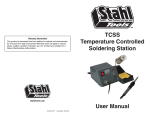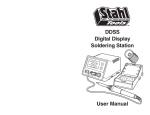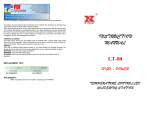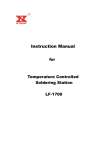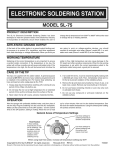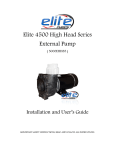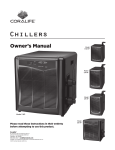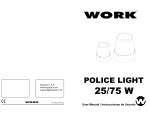Download 374-100 manual.indd
Transcript
Warranty Information This product is warranted free from defects in material and workmanship for one year from date of purchase. Warranty does not apply to misuse, abuse, neglect, accident, improper use, etc. Contact your reseller for a Return Merchandise Authorization. STSSVT Variable Temperature Soldering Station stahltools.com © Stahl Tools™ Last Revised: 6/10/2013 User Manual Care of the Tip: CAUTION: THE TIP IS PROTECTED IN SHIPMENT BY A VINYL TUBE. REMOVE THIS TUBE PRIOR TO USE TO PREVENT PERMANENT DAMAGE TO THE TIP! The tip supplied is iron plated copper; if treated property it will provide years of reliable service. 1.Always tin tips prior to switching off or storing the iron for any period of time, wipe only before use. 2.Do not keep the iron set to high temperatures for a long period of time as this will break down the surface of the tip. 3.Never clean the tip with coarse abrasive materials or files. 4.If an oxide film does form it can be cleaned by lightly rubbing with a 600-800 grit emery cloth, isopropyl alcohol or equivalent. Immediately reheat and re-tin the tip to prevent oxidation of the surface. 5.Remove the tip and clean every twenty hours of use, or at least once a week, and remove any loose build up in the tip barrel. 6.Do not use fluxes containing chloride or acid. Use only rosin or activated resin fluxes. 7.Do not use any compound or anti-seize materials on the tip surface. SAFETY PRECAUTIONS Your Stahl Soldering Station is a very safe tool, however, like all electrically operated devices, care should be exercised in the operation. Please follow the below guidelines: 1.Keep your soldering iron away from ALL flammable material. 2.Protect yourself from burns, ALWAYS assume the tip is hot. 3.Never allow the HOT soldering iron or tip to come into contact with the power cord or any other materials around your work area. 4. NEVER leave your soldering station unattended or plugged in when not in use. 5.Make sure the station is unplugged and cool before moving your station, replacing the tip, or any other adjustment, 6.Never allow your soldering unit to be dipped into any liquids. 7.Use safety goggles to eliminate the potential for any hot solder or materials to come into contact with your eyes. 8.Always solder in a well-ventilated space. 9.Make sure you use a GFI (Ground Fault Interrupter) receptacle with your soldering station and that it is not being used for any other devices or controlled from a light switch. Tip Replacement and Dressing: Tip replacement or cleaning should be done only when the iron is at room temperature. The tip can be changed or replaced simply by unscrewing the knurled nut from the barrel assembly. The station must be switched off and allowed to cool before and during this operation, as damage may result if the system is left on without the tip installed. After removing the tip, blow out any oxide dust that may have formed in the tip retaining area of the barrel. Be careful to avoid getting debris in your eyes. Replace the tip and screw the retaining knurled nut onto the barrel assembly; tighten only finger-tight. Pliers should only be used to tighten the nut if it becomes loose when the iron is hot to avoid burning your fingers. Care should be taken not to over tighten as this can damage the element. General Cleaning: The outer case of the iron or station may be cleaned with a damp cloth using a small amount of liquid detergent. Never submerse the unit in liquid or allow any liquid to enter the case of the station. Never use solvent to clean the case. Maintenance: The iron must be placed in its stand when not in use. If the supply cord becomes damaged, it must be replaced by a qualified service technician. Working Temperature: Soldering at the correct temperature is very important to ensure a perfect solder connection. If the temperature is too low the solder will not flow properly causing cold solder joints. If the temperature is too high the flux will burn and not allow the solder to flow properly. High temperature can also cause damage to the PC Board and other sensitive components. When the working temperature is set within the correct parameters suited to the particular solder being used a good joint is assured. Never touch the solder directly to tip as this will burn the flux from within the solder. The most common solder alloys used in the electronics industry is 60% tin, 40% lead (60/40). A common tip working temperature of 60/40 solder is detailed below (this may vary from manufacturer to manufacturer). Melting point Normal operation Production line operation Desoldering for small joint Desoldering for large joint 419°F (215°C) 419°F-572°F (215°C-300°C) 608°F-716°F (320°C-380°C) 599°F (315°C) 752°F (400°C)


